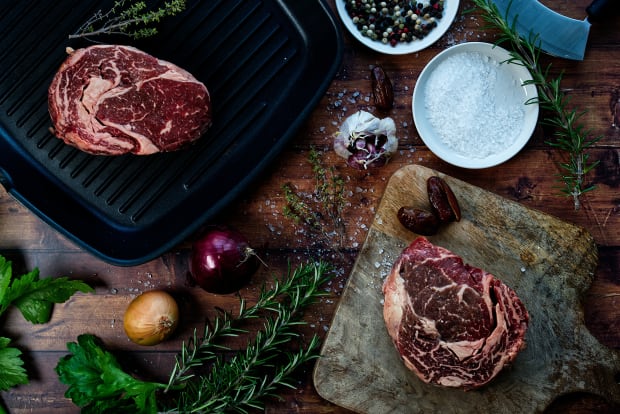[adinserter block=”2″]
*Affiliate disclosure.
As you’re lighting your grill this summer, spend a bit of time considering what you’re putting on it, especially when buying humanely raised meat. Unfortunately, it’s not as easy as shopping at organic or natural supermarkets. Whether you’re grilling chicken (try this whole grilled chipotle chicken recipe), fish, pork, or beef, here are some guidelines for ensuring that you’re only choosing the best humane meat to feed yourself, your friends, and family this summer. Be sure you’re cooking your humanely raised meat safely—check out our guide on carbon steel vs stainless vs cast iron. And, look to us for tips on how to grill vegetables, how to level up your grilled protein or veggies with this chimichurri sauce.
Looking to grill up something on the sweet side? Try this stuffed grilled peach recipe and our grilled strawberry kebabs with basil.
Never miss a tip on all (well-researched) things organic, humane, and sustainable (not to mention tons of delicious recipes), subscribe to our newsletter.
Getting Humanely Raised Meat: 5 Tips
1. Familiarize Yourself with Humane Meat Labels
It seems that every package you buy in the grocery store has some kind of buzzword on it, but they don’t always mean the same thing.
- Animal Welfare Approved
- Certified Humane
- Animal Welfare Certified
Animal Welfare Approved is one of our top choices for humane meat, with rigorous standards developed alongside a variety of professionals addressing every aspect of the species’ lifecycle needs. The ASPCA ranks this certification highly, noting that it represents “a very significant improvement over conventional standards.”
Other highly-rated labels include Certified Humane, organized by the HFAC non-profit organization. This certification notably pioneered “Pasture Raised” and “Free Range” labels for poultry to replace the unregulated use of these terms – if the HFAC has not certified these claims, they may mean very little.
The six-step certification from Animal Welfare Certified not only prohibits subtherapeutic antibiotics and hormones at all levels. It also prohibits cages and crates, and from Step 3, outdoor access is required. From Step 4, access to pasture is required.
For more information on these and other humane meat labels, this handy guide from the ASPCA is a phenomenal resource. It notably outlines indications you might see on packaging that mean less than you’d think, including natural, humanely-raised, and vegetarian-fed.
2. Choose Unique Cuts
Most grilled meat recipes opt for muscle cuts: beef tenderloins, chicken thighs, and lamb chops all feature frequently in our favorite recipes and menus. But always choosing common muscle cuts increases the demand for industrial production, whereas choosing more obscure cuts, like liver, kidney, or even tripe helps smaller producers and butchers ascribing to whole animal butchery to make a living.
Offal cuts or even whole poultry can also easily be cooked up on the grill. Grill up some delicious beef heart to venture away from flank steak and chicken breasts and explore a different side of grilling meat. We really like Made In’s grill pan for these cuts, and also their carbon steel griddle. They’re both great for camping, too
you can use them directly over the fire.
3. Pay the Price for Humane Meat

If meat is at the lower end of the price scale, chances are it’s not all that humane.
Low prices are often an indication of low-quality feed and animal exploitation. The higher prices associated with free-range chickens or grass-fed, organic beef aren’t just because of increased demand, but also due to the increased cost of raising animals humanely. In other words, if you think you’ve found a deal that seems too good to be true, chances are, it is.
The one exception would be buying bulk meat from a whole animal butchery. You can often find great deals buying in bulk via CSAs or programs like Crowd Cow or Grassland Beef (which sells US Wellness Meats).
4. Vary Your Menu
Just because you’re grilling meat doesn’t mean that needs to be the only option. Choosing to serve just a bit of high-quality meat alongside some delicious grilled vegetables is a great way to reduce your consumption of meat (and afford the pricier, better-quality cuts).
5. Finally, When Purchasing Humane Meat, Choose Local
If you want to ensure that the meat that you are buying is truly humanely raised, your best resource is the producer. Choosing local meat not only reduces the carbon footprint of your purchase, it also allows you to speak directly with the producer and ensure that the humane standards that he or she works with are in line with what you are looking for.

Related on Organic Authority
4 Vegetarian Grilling Recipes for Labor Day (It’s Also Meatless Monday!)
8 Best Grilling Accessories to Make You a Grill Master
Top 10 Grilling Safety Tips for Summer: Keep Barbecue Delicious!
*Note! This article contains affiliate links that are independently sourced and vetted by our editorial team which we may earn a commission on. This helps us reduce the number of ads we serve on Organic Authority and help deliver you a better user experience. We are here to help you navigate the overwhelming world of consumer products to source and uncover thoughtfully made, conscious clean products for you and your family.
[adinserter block=”2″]
Source link

